Catalogue > Liste par artiste
Parcourez la liste complète des artistes présentés dans le cadre des Rencontres Internationales depuis 2004. Utilisez le filtre alphabétique pour affiner vos recherches.
Ernst Karel, Pawel Wojtasik, Toby Lee
Catalogue : 2015Single Stream | Documentaire | hdv | couleur | 23:18 | USA | 2014
Ernst Karel, Pawel Wojtasik, Toby Lee
Single Stream
Documentaire | hdv | couleur | 23:18 | USA | 2014
SINGLE STREAM takes a close look at the problem of waste, through a visual and sonic exploration of a recycling facility. The title refers to the “single stream” method of recycling in which all types of recyclables are initially gathered together, and sorted later at a specialized facility. With SINGLE STREAM, viewers enter one of the largest of these materials recovery facilities in the US. Inside a cavernous building, a vast machine complex runs like clock-work, sorting a steady stream of glass, metal, paper and plastic carried on conveyor belts criss-crossing the space, dotted with workers in neon vests. The interwoven movements of human and machine produce sounds and images that are overwhelming, but also beautiful, and even revelatory. Blurring the line between observation and abstraction, SINGLE STREAM is a meditation on our society's culture of excess and its consequences.
Paweł Wojtasik (b. 1952, Łódź, Poland) creates poetic reflections on cultures and ecosystems in the form of short films and large-scale installations. His investigations into the overlooked corners of the environment have led him to pig farms, sewage treatment plants, wrecking yards and autopsy rooms. His work has shown in venues such as PS1/MoMA, Reina Sofia Museum, Berlinale and New York Film Festival. www.pawelwojtasik.com/ Toby Lee (b. 1980, Los Angeles) is an artist and scholar based in New York, working across video, installation, drawing and text. She holds a PhD in Anthropology and Film & Visual Studies from Harvard University, and she is Assistant Professor of Cinema Studies at NYU’s Tisch School of the Arts. Ernst Karel (b. 1970, Palo Alto) works between experimental nonfiction sound and electroacoustic music. He composes and performs with location recordings and/or analog electronics, often for multichannel environments. As a Lecturer on Anthropology at Harvard University, he teaches a production course in sonic ethnography. http://ek.klingt.org/
Sahraa Karimi
Catalogue : 2008Dernière | Vidéo expérimentale | dv | couleur | 3:30 | Afghanistan | 2007
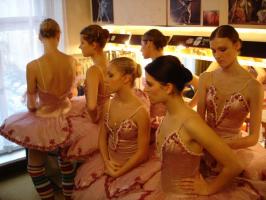
Sahraa Karimi
Dernière
Vidéo expérimentale | dv | couleur | 3:30 | Afghanistan | 2007
Une photographie et l'histoire qui se cache derrière.
Sahraa Karimi est une jeune réalisatrice afghane née à Kaboul en 1981 et vivant en Slovaquie. Elle émigre en Iran à l'âge de 15 ans puis part pour la Slovaquie cinq ans plus tard et y obtient le droit d'asile. Elle a suivi des cours de Slovaque pour passer l'examen d'entrée à l'université et est actuellement étudiante en Master d'Art à l'Academy of Music and Performing Arts, Film and TV Faculty (FTF V?MU) de Bratislava. (Slovaquie). Elle tient l'un des rôles principaux dans ?Daughters of the Sun? (1999, Mariam Shahriar), premier prix aux festivals du film de Montréal et de Bratislava, dans ?White Dream? (2000, Hamid Jebeli), et dans ?Who is Sahraa??(2002, Hossein Fazeli). Elle a elle-même réalisé plusieurs courts métrages et documentaires récompensés dans de nombreux festivals à travers le monde. Sahraa Karimi travaille actuellement sur son premier long-métrage ?AFGHAN WOMEN BEHIND THE WHEEL? '("Des afghanes au volant"). A travers plusieurs portraits de femmes afghanes apprennant à conduire, ce documentaire tourné à Kaboul témoigne de la place de la femme dans la société afghane et entend démontrer le désir de la femme afghane d'être active, utile et bénéfique à la société.
Sahraa Karimi
Catalogue : 2008Simona medzi 20. a 21. Marca | Fiction | dv | couleur et n&b | 11:0 | Afghanistan, Slovaquie | 2007

Sahraa Karimi
Simona medzi 20. a 21. Marca
Fiction | dv | couleur et n&b | 11:0 | Afghanistan, Slovaquie | 2007
Simona est une voleuse solitaire. Elle a perdu son petit ami dans un accident de voiture. Le film montre une courte période de sa vie entre le 20 et le 21 Mars pendant laquelle elle a accidentellement volé une partie de l'intimité de quelqu'un.
Sahraa Karimi est une jeune réalisatrice afghane née à Kaboul en 1981 et vivant en Slovaquie. Elle émigre en Iran à l'âge de 15 ans puis part pour la Slovaquie cinq ans plus tard et y obtient le droit d'asile. Elle a suivi des cours de Slovaque pour passer l'examen d'entrée à l'université et est actuellement étudiante en Master d'Art à l'Academy of Music and Performing Arts, Film and TV Faculty (FTF V?MU) de Bratislava. (Slovaquie). Elle tient l'un des rôles principaux dans ?Daughters of the Sun? (1999, Mariam Shahriar), premier prix aux festivals du film de Montréal et de Bratislava, dans ?White Dream? (2000, Hamid Jebeli), et dans ?Who is Sahraa??(2002, Hossein Fazeli). Elle a elle-même réalisé plusieurs courts métrages et documentaires récompensés dans de nombreux festivals à travers le monde. Sahraa Karimi travaille actuellement sur son premier long-métrage ?AFGHAN WOMEN BEHIND THE WHEEL? '("Des afghanes au volant"). A travers plusieurs portraits de femmes afghanes apprennant à conduire, ce documentaire tourné à Kaboul témoigne de la place de la femme dans la société afghane et entend démontrer le désir de la femme afghane d'être active, utile et bénéfique à la société.
Sahraa Karimi
Catalogue : 2006Hladanie Iluzil | Documentaire | betaSP | noir et blanc | 26:0 | Afghanistan | 2005
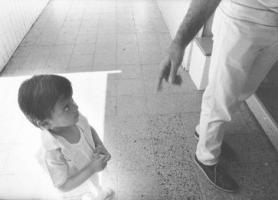
Sahraa Karimi
Hladanie Iluzil
Documentaire | betaSP | noir et blanc | 26:0 | Afghanistan | 2005
"The film is about asylum seekers who are leaving in Gabcikovo refugee camp in Slovakia and their every day life, which is passing unused. The most of them are there more than three years, but still did not get asylum. The only contact is phone, by what they can contact with the world of out side. Phone, which makes them happy or angry. Phone, which gives them a new hope. Film is trying to show relationship between refugees and phone and place where they are already there. I choose this place, maybe for this reason that the Gabcikovo refugee camp is a very special place for me too. 3 years ago, I came there and I spent there several months of my life, which were full of sorrows. By this film, I have tried at least to speak with myself and believe it that we did not born because of world, the world created because of us."
Sarah Karimi was born in 1981 in Kabul. In 2004, she enters at The Academy of Music and Performing Arts(major documentary 1997-2000) and takes course of camera 1998-1999, course of singing 1999-2000 and Creative writing.
Jackie Karuti
Catalogue : 2018There Are Worlds Out There They Never Told You About | Animation | hdv | couleur et n&b | 1:6 | Kenya | 2016
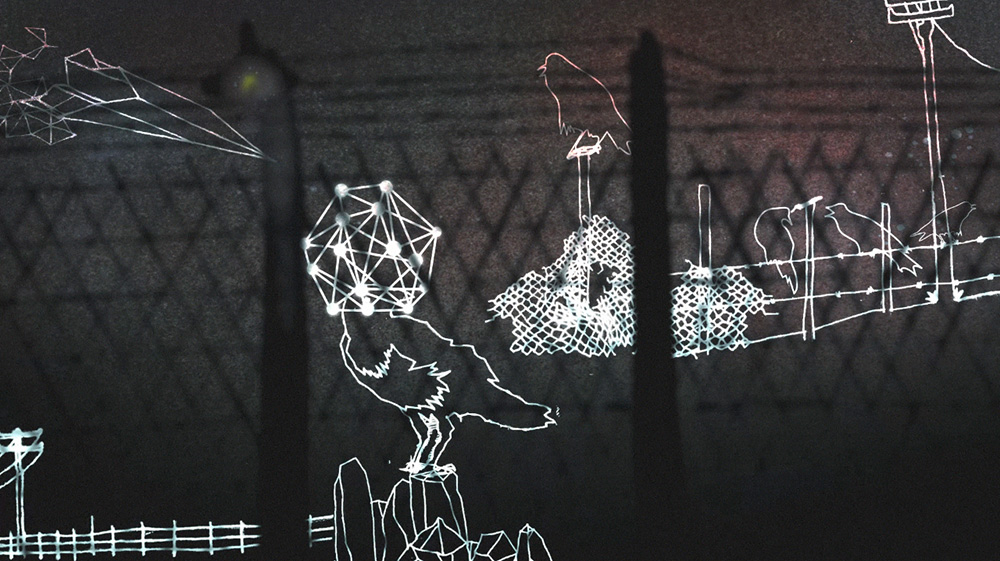
Jackie Karuti
There Are Worlds Out There They Never Told You About
Animation | hdv | couleur et n&b | 1:6 | Kenya | 2016
There are worlds out there they never told you about, 2017 is a video that is part of a larger body of work under the same title. While rightfully addressing tragic stories of migration through water, the work viewed collectively through drawings and new media is also about reimagining freedom through the imagination and creation of fantastic worlds. Worlds that are less about occupying physical space but more about cultivating ways that one can be free in a place where home and freedom remain elusive.
Jackie Karuti is an artist based in Nairobi. Her practice is largely experimental and employs the use of new media through drawings, video, installations and performance art. Her work is founded on ideas around knowledge production & accessibility as well as the depths of possibility enabled by radical imagination. Karuti is the 2017 recipient of the Young Artist Award at the Cape Town Art Fair, an alumna of the Gasworks residency program in London as well as Asìko, a roaming Pan African art school designed to redress the frequently outdated or non-existent artistic and curatorial curricula at tertiary institutions across Africa. In 2017 she was shortlisted for the residency program at The Rijksakademie. Karuti has participated in several exhibitions & residencies, both locally & abroad as well as multidisciplinary projects such as curating the Out Film Festival-Nairobi (2016-2018). In 2017 she established the online platform, I’ve Been Working on Some MAGIC which seeks to engage Nairobi based visual artists in critical writing, collective curatorial projects as well as sharing audiovisual material. In 2018 Karuti’s work will debut at the 13th edition of the Dak’Art Biennial in Dakar, Senegal.
Dagmar Kase
Catalogue : 2007E-Media Centre, Estonian Academy of Arts | 0 | 0 | | 0:0 | Estonie | 2007

Dagmar Kase
E-Media Centre, Estonian Academy of Arts
0 | 0 | | 0:0 | Estonie | 2007
Constitué en 1994, réorganisé en 2000, le Centre E-Media (EMC) se concentre sur la recherche, l'enseignement et la promotion de la culture numérique et de l'art en Estonie. L'EMC est ouvert aux étudiants pour qu'ils acquièrent des compétences dans le multimédia et l'information, ainsi que des compétences dans la réalisation de projets d'étude. Le centre offre la possibilité de créer différents projets avec les techniques des médias numériques, organise le prêt d'équipement et des conférences à l'Académie des Arts d'Estonie. Le programme du Master en Multimédia Interactif (IMM) est disponible depuis l'année académique 2000/2001. Le MA de deux ans est organisé en modules pour offrir des compétences théoriques et pratiques en média numériques. Les études sont menées sous forme de conférences et ateliers traditionnels, aussi bien que sous forme de séminaires/conférences en ligne sollicitant des spécialistes et conférenciers internationaux. Outre la dimension enseignement, le EMC accueille régulièrement de plus petits événements : ateliers spéciaux, cours et symposium permettant aux étudiants, aux artistes, ainsi qu'à un large public de maîtriser des techniques essentielles. Le centre invite des enseignants et des spécialistes d'horizons internationaux à dialoguer avec des étudiants, artistes, enseignants locaux afin de stimuler les discussions et les échanges de nouvelles idées. Le centre participe à différents projets, différentes recherches, résidences d'artiste et réseaux de coopération. Le centre a collaboré avec Hypermédia Research Center de l'Université de Westminster à Londres, l' Electronic Music Studio de l'Académie de musique d' Estonie, le Centre d'Art Contemporain, le Musée d'Art d'Estonie ou m-Cult d' Helsinki ( en 2004, le Centre co-accueillait avec m-Cult ISEA2004) pour n'en citer que quelques-uns. Actuellement le EMC est un membre actif de TMC (Tallinn Media Cluster) et NICE network ( en 2003 NICE a offert un fond commun pour les initiatives de la nouvelle culture média dans la région baltique avec des projets associés comme RAM (Re-Approaching New Media), une série d'ateliers et de conférences. De plus, le Centre E-Media s'est impliqué dans des programmes d'artistes en résidence comme NIFCA et Map XXL.
Dagmar Kase obtient un BA en scénographie en 2001 à l'Académie des Arts d'Estonie (EEA), un MA en Multimédia Interactif en 2004 et étudie la Théorie de la Culture depuis 2005 à l'Estonian Institute of Humanities à l'Université de Tallinn. Elle est membre de l'Association des Artistes Estoniens et de l'Union des Artistes Media Estoniens. Elle dirige le Centre E-Media à l'Académie des Arts d'Estonie. Elle travaille plus particulièrement avec la vidéo, la photographie, le texte, le son et les installations interactives. Ses travaux traitent de notre société contemporaine qui est un organe global joueur qui fonctionne comme une totalité d'éléments et dont les questions centrales sont le temps, l'espace et le lieu, la mémoire et l'idendité. Elle pense qu'il est important de méditer sur le monde qui nous entoure et de s'y impliquer plus profondément pour saisir l'importance des choses et des événements simples. Elle combine la théorie et la pratique afin de créer des travaux interdisciplinaires.
Wojciech Kasperski
Catalogue : 2007Nasiona | Documentaire | dv | couleur | 27:9 | Pologne | 2005
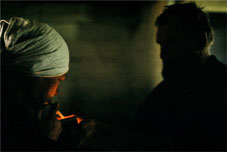
Wojciech Kasperski
Nasiona
Documentaire | dv | couleur | 27:9 | Pologne | 2005
A small village in the beautiful mountains of southern Siberia. A family living out of the way, not accepted by the society. They have their own secrets. Step by step, we get involved in their mysterious world. Strong characters, complicated relationships, and an uncovered story in the background. No fiction. Real world, no matter how surrealistic it appears to be. Real people. Real life. Real story.
Julia Kater
Catalogue : 2017Breu | Vidéo | hdv | couleur | 4:0 | Brésil | 2016
Julia Kater
Breu
Vidéo | hdv | couleur | 4:0 | Brésil | 2016
In Breu (Pitch black), the recorded images present, in a non-linear montage, the semi-artisanal paving process of a rectangle arbitrarily drawn in the middle of a vacant lawn. The soundtrack brings a circular text that overflows in modal adverbial adjuncts (mainly right and wrong),without defining any clear object, the text builds the speech in an endless cycle, onto which the ideas of progress and evolution cannot be applied.
JULIA KATER | 1980 ‘ Paris, France Lives and works in Sao Paulo, Brazil. Graduated in Photography from the School of Advertising and Marketing - ESPM (Sao Paulo - Brazil). The research of the artist Julia Kater is guided in the elaboration of a body of work that can treat it from its visual improbability. Whether by the collage brought about by different overlaid photographic prints, which announces a watchful sky ‘ despite its invisible character ‘ or by videos that bring about the rearrangement of a set of actions and phrases, each work in its own way prioritizes the elaboration of bodies from everyday scenes that suggest simultaneous shared experiences with the persistent memory together with its struggle with forgetfulness, its ally and the cause of the gradual loss of a large part of the truths. Kater regularly participates in exhibitions in Brazil and abroad, in countries like France, USA, Belgium and Portugal.
Timo Katz
Catalogue : 2007Whirr | Vidéo expérimentale | dv | couleur | 3:0 | Allemagne | 2006
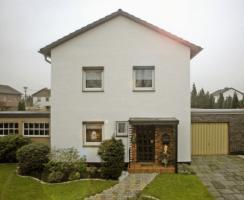
Timo Katz
Whirr
Vidéo expérimentale | dv | couleur | 3:0 | Allemagne | 2006
C'est de façon rythmée que se révèlent les variations que les habitants d'un lotissement ont apportées au modèle standardisé de leur maison. La caméra ouvre, sur l'organisation schématique des bâtiments, un espace de pluralité et de constante variabilité. Les transformations de la surface architecturale apparaissent par oscillations. Le concret danse - sur la piste de l'abstrait.
Timo Katz est né en 1977 à Siegen. De 1999 à 2006 il étudie la photographie et le design de films à l'Ecole Supérieure de Bielefeld et obtient son diplôme de designer en Février 2006. Il vit à Bielefeld et travaille sur des projets de films expérimentaux ainsi que sur des commandes.
Timo & Jan Katz & Fuchs
Catalogue : 2009die Welt | Installation vidéo | dv | couleur | 5:0 | Allemagne | 2008

Timo & Jan Katz & Fuchs
die Welt
Installation vidéo | dv | couleur | 5:0 | Allemagne | 2008
Le travail vidéo expérimental ?Die Welt? porte sur la perception spatio-temporelle dans notre expérience visuelle du monde. Notre perception est non seulement définie par la photographie, mais surtout par les règles de la perspective centrale. Celle-ci montre et explique le monde visible à travers une simplification schématique. Le travail présenté s?intéresse à l?utilisation élargie de la caméra comme prothèse d?observation pour la découverte et la reconnaissance du visible. La perspective centrale est ici éventrée et déstructurée. L?espace visuel, s?appuyant sur le panorama d?un paysage urbain, est transcrit en une multiperspective parallèle, que l?on atteint en séparant l?image de la caméra en tranches ordonnées à la verticale, et qui ressemble ainsi à la perspective de prise de vue d?un scanner. La pièce, envisagée à travers ce procédé de destructuration, subit un décalage autant spatial que temporel. Le montage, et seulement le montage, permet ainsi de rendre visible un Espace-Temps-Vision alterné. Il se pose la question de la signification, pour notre perspective visuelle, de l?élargissement technique croissant de notre outil d?observation, et de ses conséquences au présent et à l?avenir. Il souligne en outre notre tendance à nous appuyer de plus en plus sur des modèles de perception déjà construits.
Timo Katz est né en 1977 à Siegen. Il étudie le design photo- et filmographique à l?Ecole Supérieure de Bielefeld où il obtient son diplôme en 2006. Il travaille depuis 2002 dans le domaine des vidéos et films expérimentaux. Il vit et travaille actuellement à Leipzig. Il forme avec Jan Fuchs le groupe indépendant de recherches visuelles Katz&Fuchs. Jan Fuchs est né en 1976 à Hamburg. Il étudie le design photo-et filmographique à l?Ecole Bielefeld et obtient son diplôme en 2004. Il travaille depuis 2002 dans le domaine des vidéos et films expérimentaux. Il vit et travaille à Kassel. Il forme avec Timo Katz le groupe indépendant de recherches visuelles Katz&Fuchs.
Naomi Kawase
Catalogue : 2007Naissance et maternité | Documentaire | dv | couleur | 60:0 | Japon | 2005
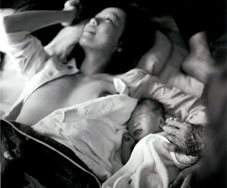
Naomi Kawase
Naissance et maternité
Documentaire | dv | couleur | 60:0 | Japon | 2005
Naissance et maternité Réalisatrice : Naomi Kawase Producteur : Sento Inc. Naomi Kawase 60? La cinéaste Naomi Kawase, devenue mère, poursuit dans ce nouveau film documentaire, son ?uvre personnelle d?interrogation du monde. En effet, le 24 avril 2004 à 10h40, naissait son fils Mitsouki. La naissance a eu lieu, de manière traditionnelle, sans médecin, avec la seule assistance d?une sage-femme, dans une vieille maison japonaise, sur un tatami. Naomi Kawase y était entourée des membres de sa famille. Quand le cordon ombilical a été coupé, Naomi a pris la caméra et enregistré ce moment hautement symbolique, de même qu?elle a filmé toutes les personnes qui l?ont affectueusement assistée. Depuis, Naomi Kawase vit et filme au jour le jour son fils et sa grand-mère de 90 ans dans leur vieille maison de Nara. Le film se développe sur deux dimensions : celle de l?enfant grandissant sous le regard attentif de sa mère et de son arrière grand-mère et celle de la propre enfance de Naomi Kawase racontée à la première personne.
George Kazazis
Catalogue : 2006Mickey, Mickey where are you? | Art vidéo | dv | couleur | 3:25 | Grèce | 2004
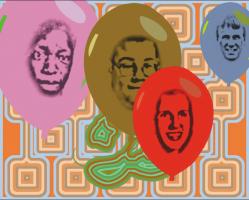
George Kazazis
Mickey, Mickey where are you?
Art vidéo | dv | couleur | 3:25 | Grèce | 2004
Nous sommes constamment inondés par des images de violence, et en même temps par des images de styles de vie. Le contraste est sans conteste énorme. Les sentiments variant, mais, de n?importe quelle manière nous les regardons, les deux genres existent avec tellement de vie qu?ils en sont indispensables. Le matin du 20 avril 1999, deux jeunes américains, Eric Harris, âgé de 15 ans et Dylan Klebal, âgé de 18 ans, vinrent à leur collège de Colombia dans la ville de Littletown aux Etats-Unis, emportant avec eux des armes à feu et des grenades à main. Ils tuèrent 14 de leurs camarades et un professeur. La plupart des victimes se trouvèrent dans la cafétéria de l?école. L?incident dans son ensemble fut enregistré par les caméras de sécurité de l?établissement. L?évènement est si important en lui-même qu?il a même éclipsé la lumière d?un symbole national. La vidéo commence avec Mickey et Minnie Mouse dans différentes poses, courant, virevoltant dans un nuage de couleurs vives. Est-ce que c?est une fête ou un bain de sang ? La musique qui vient de la chanson "My Cat Fell In The Well" (1983) par Manhattan Transfer les accompagne, néanmoins insouciant et à la fois persistant. La chanson raconte d?une manière douve une histoire dramatique d?un beau chat-star qui est tombé dans un puit et la détresse de son propriétaire quand il l?a retrouvé. Soudain, la musique s?arrête et la vidéo montre des visages d?enfants tués sans foi ni loi, les mêmes enfants qui croyaient en l?innocence de ce Mickey Mouse ou n?importe quel autre Mickey Mouse. Pour notre salut, ces images stoppent et Mickey réapparaît, la musique recommence. La fin ne nous concerne plus. Cela ne pourrait jamais nous arriver.
Georges Kazazis est né à Atlanta en 1958 où il travaille et vit. Il est allé enseigner à l?école des Beaux-Arts d?Athènes à partir de 1990. Il fut aussi membre du Project Sapce Athènes (un espace pour plusieurs artistes fondé en 2000-2001)
David Kelley
Catalogue : 2023The Book of the Dead | Doc. expérimental | 4k | couleur | 19:42 | USA | 2023
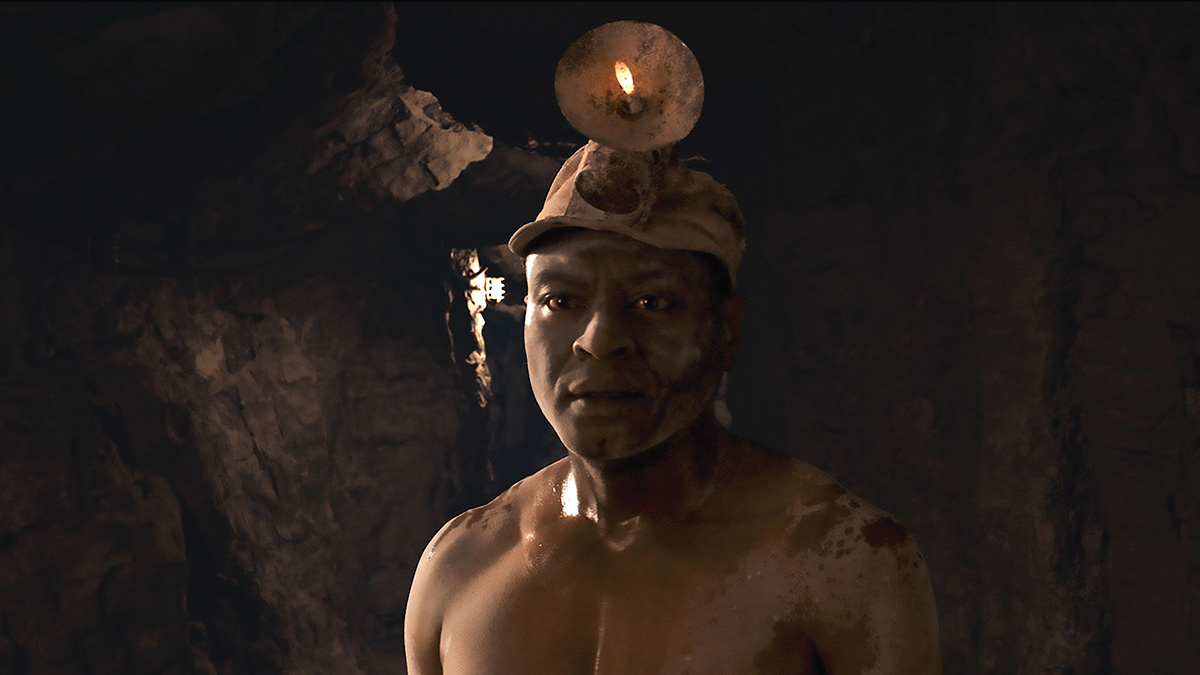
David Kelley
The Book of the Dead
Doc. expérimental | 4k | couleur | 19:42 | USA | 2023
The Book of the Dead is an experimental documentary meditating on the American poet Muriel Rukeyser’s poem about the Gauley Tunnel tragedy. In the 1930s in West Virginia, nearly 2,000 primarily Black migrant workers were sickened or killed by silicosis, a lung disease caused by breathing silica dust. Rukeyser travelled to West Virginia to meet workers and their families, in some cases, appropriating their words directly. The film revises her white characters to a predominately Black cast — more accurately reflecting the insidious racism prevalent in American society at the time. The film appropriates interviews with the poet, her unfinished screenplay, and worker’s testimony to U.S. Congress. Using actors, theatrical sets, and 3D generated backgrounds, the film produces a multisensory experience of Rukeyser’s process and the industrial tragedy. Unable to travel during the Covid-19 pandemic, Kelley designed the West Virginia mining sets in Unreal, a 3D gaming software and filmed actors at a green screen studio near his home in Los Angeles. The work's theme of failure to breathe poignantly resonates with the Covid-19 pandemic, and the final words turned protest chant of George Floyd: I can't breathe.
David Kelley (Born in Portland Oregon. Lives in Los Angeles California.) Kelley is an artist working with photography, video, and installation. His recent projects draw attention to the effects of global capitalism, resource extraction, and shifting physical and political landscapes. Influenced by a range of visual traditions, Kelley draws upon elements of experimental documentary, ethnography, performance, and avant-garde cinema. By working at the intersection of these strategies, he encourages an understanding of his subjects that is simultaneously direct and speculative. His work has been shown in galleries and museums nationally and internationally. Recent exhibitions include the Museum of Modern Art in New York and Fotofest Biennial, Houston. Other exhibitions include Commonwealth and Council in Los Angeles, The Bank in Shanghai, the de Cordova Biennial in Boston, BAK in Utrecht, MAAP space in Australia, and the Jim Thompson Art Center in Bangkok. Kelley received a Master of Fine Art from the University of California, Irvine, and was a 2010 -11 resident at the Whitney Museum of American Art Independent Study Program. He is currently based in Los Angeles, California, and is an Associate Professor of the Practice at the Roski School of Art and Design, University of Southern California.
David Kelley
Catalogue : 2026African Union | Film expérimental | mp4 | couleur | 4:4 | USA | 2025
David Kelley
African Union
Film expérimental | mp4 | couleur | 4:4 | USA | 2025
African Union répond aux révélations de 2018 concernant la surveillance chinoise au siège de l’Union africaine à Addis-Abeba. Réalisé à partir d’IA générative, d’images commerciales issues de banques d’images et de séquences documentaires, le film explore l’impérialisme numérique, l’extraction des données, et les enchevêtrements idéologiques de l’intelligence artificielle au sein des dynamiques politiques et technologiques en constante évolution entre la Chine et l’Afrique.
David Kelley explore les écologies cachées de l’infrastructure globale — de l’extraction minière en eaux profondes et la route de la soie aux sables bitumineux de l’Alberta et à l’extraction des terres rares en Chine. Travaillant entre film, photographie, installation et sculpture, il examine comment la technologie, la modernité, l’écologie et la mémoire opèrent comme des systèmes de médiation interdépendants. Sa pratique s’inspire du film-essai, de l’ethnographie expérimentale et du théâtre expérimental, utilisant la forme comme un espace d’expérience affective, d’ambiguïté et de transgression. Kelley envisage la recherche comme un processus esthétique, privilégiant les modes sensoriels et spéculatifs plutôt que purement discursifs. Ses projets impliquent souvent des productions in situ, des recherches d’archives et l’intégration d’objets du quotidien ou de constructions théâtrales au sein d’environnements immersifs. Des spécimens scientifiques — empruntés à des collections d’histoire naturelle ou réinterprétés en verre, céramique ou pierre — ancrent ses installations dans une histoire matérielle tout en ouvrant la voie à des rencontres surréelles et spéculatives. Son travail a été exposé à l’international, notamment au Museum of Modern Art de New York, aux Rencontres Internationales Paris/Berlin et à The Bank, Shanghai. Ses prochaines présentations incluent le LACMA à Los Angeles et la Global Visions FotoFest Biennial 2026 à Houston. Kelley est titulaire d’un MFA de l’UC Irvine et a été boursier du Whitney Independent Study Program en 2010–2011.
Catalogue : 2019Spiritual Myopia | Film expérimental | hdv | couleur | 15:0 | USA | 2018
David Kelley, Patty Chang
Spiritual Myopia
Film expérimental | hdv | couleur | 15:0 | USA | 2018
Spiritual Myopia is a film dealing with the invisible labor and desire of the residents of the oil industry boom towns of Fort McMurray in the Canadian Tar Sands and the refining town of Port Arthur Texas. The two cities are terminal nodes of the proposed Keystone XL oil pipeline which would span the United States. Fort McMurray is the third largest oil deposit in the world. Its rapid pace of growth has meant a dearth of housing for its migrant workers. Port Arthur boasts the world’s largest concentration of oil refineries and its town center has nearly disintegrated from economic decline. These twin cities are related spatially as nodes in the same energy infrastructure, and temporally in their different stages of a boom or bust economy. Borrowing its title from Alfred Stieglitz’s photo Spiritual America, Spiritual Myopia speaks to the nearsightedness innate to hypercapitalism.
Spiritual Myopia is a collaboration between artists David Kelley and Patty Chang Patty Chang (Lives and works in Los Angeles, CA) Patty Chang is an artist working in performance, video, writing, and installation. Her work has a capacity to explore complex subjects nearly simultaneously, as does life. Her work has been exhibited nationwide and internationally at such institutions as the Museum of Modern Art, New York; Solomon R. Guggenheim Museum, New York; New Museum, New York; BAK, Basis voor actuele Kunst, Utrecht, the Netherlands; the Hammer Museum, Los Angeles; Fri Art Centre d’Art de Freibourg, Fribourg, Switzerland; Chinese Arts Centre, Manchester, England David Kelley (Lives in Los Angeles California, CA.) David Kelley’s work is a hybrid of experimental documentary and ethnographic practices that make use of imaginary, choreographic and performative strategies. His work has been shown in galleries throughout the world. Recently, he has had exhibitions at the Museum of Modern Art in New York, White Box in Portland Oregon, and Commonwealth and Council in Los Angeles. Other recent exhibitions include The Bank in Shanghai, New Art Center, the de Cordova Biennial in Boston, BAK in Utrecht, MAAP space in Brisbane Australia.
David Kelley, Patty Chang
Catalogue : 2026African Union | Film expérimental | mp4 | couleur | 4:4 | USA | 2025
David Kelley
African Union
Film expérimental | mp4 | couleur | 4:4 | USA | 2025
African Union répond aux révélations de 2018 concernant la surveillance chinoise au siège de l’Union africaine à Addis-Abeba. Réalisé à partir d’IA générative, d’images commerciales issues de banques d’images et de séquences documentaires, le film explore l’impérialisme numérique, l’extraction des données, et les enchevêtrements idéologiques de l’intelligence artificielle au sein des dynamiques politiques et technologiques en constante évolution entre la Chine et l’Afrique.
David Kelley explore les écologies cachées de l’infrastructure globale — de l’extraction minière en eaux profondes et la route de la soie aux sables bitumineux de l’Alberta et à l’extraction des terres rares en Chine. Travaillant entre film, photographie, installation et sculpture, il examine comment la technologie, la modernité, l’écologie et la mémoire opèrent comme des systèmes de médiation interdépendants. Sa pratique s’inspire du film-essai, de l’ethnographie expérimentale et du théâtre expérimental, utilisant la forme comme un espace d’expérience affective, d’ambiguïté et de transgression. Kelley envisage la recherche comme un processus esthétique, privilégiant les modes sensoriels et spéculatifs plutôt que purement discursifs. Ses projets impliquent souvent des productions in situ, des recherches d’archives et l’intégration d’objets du quotidien ou de constructions théâtrales au sein d’environnements immersifs. Des spécimens scientifiques — empruntés à des collections d’histoire naturelle ou réinterprétés en verre, céramique ou pierre — ancrent ses installations dans une histoire matérielle tout en ouvrant la voie à des rencontres surréelles et spéculatives. Son travail a été exposé à l’international, notamment au Museum of Modern Art de New York, aux Rencontres Internationales Paris/Berlin et à The Bank, Shanghai. Ses prochaines présentations incluent le LACMA à Los Angeles et la Global Visions FotoFest Biennial 2026 à Houston. Kelley est titulaire d’un MFA de l’UC Irvine et a été boursier du Whitney Independent Study Program en 2010–2011.
Catalogue : 2019Spiritual Myopia | Film expérimental | hdv | couleur | 15:0 | USA | 2018
David Kelley, Patty Chang
Spiritual Myopia
Film expérimental | hdv | couleur | 15:0 | USA | 2018
Spiritual Myopia is a film dealing with the invisible labor and desire of the residents of the oil industry boom towns of Fort McMurray in the Canadian Tar Sands and the refining town of Port Arthur Texas. The two cities are terminal nodes of the proposed Keystone XL oil pipeline which would span the United States. Fort McMurray is the third largest oil deposit in the world. Its rapid pace of growth has meant a dearth of housing for its migrant workers. Port Arthur boasts the world’s largest concentration of oil refineries and its town center has nearly disintegrated from economic decline. These twin cities are related spatially as nodes in the same energy infrastructure, and temporally in their different stages of a boom or bust economy. Borrowing its title from Alfred Stieglitz’s photo Spiritual America, Spiritual Myopia speaks to the nearsightedness innate to hypercapitalism.
Spiritual Myopia is a collaboration between artists David Kelley and Patty Chang Patty Chang (Lives and works in Los Angeles, CA) Patty Chang is an artist working in performance, video, writing, and installation. Her work has a capacity to explore complex subjects nearly simultaneously, as does life. Her work has been exhibited nationwide and internationally at such institutions as the Museum of Modern Art, New York; Solomon R. Guggenheim Museum, New York; New Museum, New York; BAK, Basis voor actuele Kunst, Utrecht, the Netherlands; the Hammer Museum, Los Angeles; Fri Art Centre d’Art de Freibourg, Fribourg, Switzerland; Chinese Arts Centre, Manchester, England David Kelley (Lives in Los Angeles California, CA.) David Kelley’s work is a hybrid of experimental documentary and ethnographic practices that make use of imaginary, choreographic and performative strategies. His work has been shown in galleries throughout the world. Recently, he has had exhibitions at the Museum of Modern Art in New York, White Box in Portland Oregon, and Commonwealth and Council in Los Angeles. Other recent exhibitions include The Bank in Shanghai, New Art Center, the de Cordova Biennial in Boston, BAK in Utrecht, MAAP space in Brisbane Australia.
David Kelley
Catalogue : 2025Non Human | Vidéo | 4k | couleur | 10:34 | USA | 2022
David Kelley
Non Human
Vidéo | 4k | couleur | 10:34 | USA | 2022
NON HUMAN is a film made from poems written in collaboration with an Artificial Intelligence (recurrent neural network) and five artists — York Chang, Marcus Civin, Tia-Simone Gardner, Viet Le, and Yvonne Rainer. Inspired by poet Muriel Rukeyser’s technique for writing The Book of the Dead (1937), a poem in which she directly quotes workers’ voices from congressional testimony about the Hawk’s Nest mining catastrophe that killed nearly 2000 miners, 80% of whom were Black workers. NON HUMAN was filmed in rural Vermont in disused marble, quarries, hospitals, and local artists’ studios and it presents leisure time and creative space as conditions to excavate the unwritten histories of labor, racism, and environmental destruction in local American communities. The generative AI used to write the script was trained with Rukeyser’s Collected Poems, the congressional testimony of workers that she quoted, and contemporary critical race and eco-feminist theories of Kathryn Yussof, Tavia Nyong’o, Saidiya Hartman, and Hortense Spillers. In Hartman’s essay The Dead Book Revisited she asks “how do we attend to black death? How do we find life where only the traces of destruction remain?” NON HUMAN’s critical AI writing machine, fed by historic documentary materials, poetry that witnesses to extractive capitalism and anti-black racism, speculates on Hartman’s question. Live performers in NON HUMAN include: sound engineer Ben Arindell, singer/song-writer Patrick Sargent, physician Jeffrey Yucht, critic Marcus Civin, sculptor Fred X Brownstein, and sound technician Jack Schlandt.
David Kelley is an artist working in photography, video, and installation. His recent projects explore the impacts of global capitalism, resource extraction, and evolving landscapes, combining elements of experimental documentary, ethnography, and avant-garde cinema to offer a perspective that is both grounded and speculative. His work has been shown nationally and internationally at venues such as the Museum of Modern Art in New York, Rencontres Internationales Paris/Berlin, Fotofest Biennial in Houston, Commonwealth and Council in Los Angeles, The Bank in Shanghai, and the Jim Thompson Art Center in Bangkok. Kelley holds an MFA from the University of California, Irvine, and was a resident of the Whitney Museum Independent Study Program. He is based in Los Angeles, where he is an Associate Professor of Fine Arts at the University of Southern California.
Graham Kelly
Catalogue : 2022Skull Island Part III | Vidéo | 4k | couleur | 34:46 | Royaume-Uni, Pays-Bas | 2020
Graham Kelly
Skull Island Part III
Vidéo | 4k | couleur | 34:46 | Royaume-Uni, Pays-Bas | 2020
Skull Island is an ongoing series of lectures, films and installations that examine a hypothetical image environment as an introspective space that reflects the sociopolitical contexts of its audience. Using the fictional island from King Kong as an analogy, cultural and technological developments define a relative position from which the viewer can view and question their surroundings. Part III is structured around two artefacts found in the visual effects archive of Berlin’s Deutsche Kinemathek Museum of Film and Television. A cast of the skull of the original armature for the stop-motion model of King Kong (Merian C. Cooper and Ernest B. Schoedsack, 1933) and a silicone mask constructed for Kevin Bacon’s computer-generated invisible character in Hollow Man (Paul Verhoeven, 2000) create a framework in which to discuss the surfaces and armatures or the skin and bones of moving images. The film examines the inherent hidden material and socio-political properties of moving images, the perpetuation of insidious ideological constructs in cinematic remakes or reboots, and traumas encapsulated in the sites and systems of moving image production.
Graham Kelly is a visual artist and filmmaker. His practice is situated in the interfaces between contemporary forms of images, physical bodies, and environments. By considering these interactions as engulfing and continuous states or effects, his work seeks to expose and dissect power structures that are cast, distorted or enforced within them. His works have been screened and exhibited in a number of international contexts that include: Haus der Kulturen der Welt, Kino der Kunst, EYE Filmmuseum, TENT, Transmission, NEST, Recontres Internationales, and LUX. He was a resident at the Jan van Eyck Academy in 2015/16 and at AIR Berlin Alexanderplatz in 2018.
Catalogue : 2017Skull Island | Doc. expérimental | hdv | couleur et n&b | 18:7 | Royaume-Uni, Pays-Bas | 2016
Graham Kelly
Skull Island
Doc. expérimental | hdv | couleur et n&b | 18:7 | Royaume-Uni, Pays-Bas | 2016
Skull Island is an ongoing series of video works, lectures and installations that use the fictional island from the various versions of King Kong as analogies for hypothetical image environments. Each island provides a means of manifesting and examining an introspective image space that reflects the sociopolitical contexts of its audience. The cultural and technological developments displayed within each version of the film define relative positions from which the viewer can question their current perceived surroundings. After being captured by a camera crew within this otherwise inaccessible territory, Kong escapes into the physical context to confront the audience with their internal fears and shared cultural constructs.
Graham Kelly (b. 1982, Ayr, Scotland) is an artist and writer based in Rotterdam and Brussels. Previous exhibitions, screenings and lectures include: Transmission Gallery (Glasgow), Intermedia (Glasgow), Generator Projects (Dundee), Kino der Kunst (Munich), TENT (Rotterdam), EYE Film Museum (Amsterdam) and the 2016 Moscow International Biennale for Young Art. He graduated from the Glasgow School of Art in 2009 with a Masters in Research and with a Masters in Fine Art in 2014 from the Piet Zwart Institute, Rotterdam. He was a resident at the Jan van Eyck Academy in Maastricht between 2015 and 2016 and is the recipient of the Mondriaan Fonds Werkbijdrage Jong Talent and Centrum Beeldende Kunst O&O subsidies and a Scottish Arts Council Creative and Professional Development Award.
Chris Kennedy
Catalogue : 2011lay claim to an island | Doc. expérimental | 16mm | couleur et n&b | 12:0 | Canada, Tuvalu | 2009
Chris Kennedy
lay claim to an island
Doc. expérimental | 16mm | couleur et n&b | 12:0 | Canada, Tuvalu | 2009
Texts from the 1969 American Indian Occupation of Alcatraz and letters from supporters propel an exploration of political yearning, emancipatory architecture and failed utopias. What does it mean to claim land that has more value as a symbol than as a potential home? And how does that symbol function beyond the boundaries of its geographic limits?
Chris Kennedy is an independent filmmaker, programmer and writer currently living in Toronto. He programmed for the Images Festival from 2003-06, Pleasure Dome from 2000-06 and co-founded the ongoing screening series Early Monthly Segments in 2009. His short experimental films have screened at over one hundred film festivals worldwide and he has presented film programs in Egypt, Belgium, Germany, the US and Canada. He holds an MFA from the San Francisco Art Institute.
Nicolas Keroulas
Catalogue : 2021Tasmant | Fiction expérimentale | 4k | couleur | 23:5 | France | 2020
Nicolas Keroulas
Tasmant
Fiction expérimentale | 4k | couleur | 23:5 | France | 2020
Une nuit, un homme étrange apparaît. Arrivé non loin des côtes, il croise le chemin d’un fantôme, qu’il se décide à suivre.
Nicolas Keroulas est né en 1997.
Minne Kersten
Catalogue : 2026Where I M Calling From | Vidéo | 0 | couleur | 5:40 | Pays-Bas, France | 2025
Minne Kersten
Where I M Calling From
Vidéo | 0 | couleur | 5:40 | Pays-Bas, France | 2025
Where I'm calling from était une exposition de nouvelles œuvres de l’artiste Minne Kersten, basée aux Pays-Bas. Travaillant avec l’architecture de la David Dale Gallery, Minne a construit un environnement détaillé et évocateur qui explore la capacité narrative des objets inanimés et leur rôle dans l’activation de la mémoire de manière transportante. Minne adopte une approche littéraire dans son travail, mêlant installation, vidéo, sculpture et dessin pour façonner le décor d’un monde fictionnel. À travers ses installations immersives, elle révèle des bâtiments attentifs aux histoires et aux traumatismes, mettant en scène des situations soumises au chaos, à la décomposition et à la déconstruction. Minne explore les traces d’événements laissées derrière elles et les expose comme les témoins d’histoires privées conservées par les murs qui nous entourent. Son travail interroge la relation entre le réel et l’imaginé, l’ordinaire et l’étrange, et pose des questions sur la mémoire et ses reconstructions. Travaillant à travers une variété de médias, elle entremêle des thèmes personnels tels que le deuil, la perte et la mémoire avec le domaine collectif de la fiction, des fables et des symboles.
Minne Kersten (1993, NL) est une artiste basée à Paris et Amsterdam, travaillant la vidéo, l’installation et la peinture. Sous ces médiums se déploie une approche littéraire dans laquelle elle combine plusieurs techniques pour construire un monde où objets et scènes portent les traces du factuel comme de la fiction. Elle spécule sur les manières dont nous pouvons nous souvenir d’événements, de souvenirs et d’histoires, en suivant ce qui se perd dans ce qui demeure. Son travail interroge la relation entre le réel et l’imaginé, l’ordinaire et l’éphémère, et pose des questions sur la mémoire et sa reconstruction. En attirant l’attention sur l’acte même de construire — autant dans notre monde partagé que dans nos imaginaires — son travail tisse un lien entre des thèmes intimes tels que le deuil, la perte et le désir, et le domaine collectif de la fiction, des fables et de la fabrication des symboles. La peinture et le dessin sont continuellement produits au cours d’un processus d’introspection et de recherche. Ils servent de prise de notes visuelle, élaborée en parallèle de ses approches spatiales. Ces dernières années, elle a développé une méthode consistant à fabriquer un environnement architectural qui se révèle être une scénographie, un décor de film, puis une sculpture. Souvent nourries par des rencontres personnelles avec des lieux, ces sculptures offrent un terrain tangible pour explorer comment un espace peut témoigner ou déformer des récits et des événements. En mettant en scène des situations qui intègrent des éléments symboliques, tels que l’apparition d’animaux ou de présences fantomatiques, elle évoque les façons dont le passé peut laisser son empreinte sur le présent. En soumettant ses scènes au chaos, à la décomposition et à la perturbation, elle suggère différentes issues à cette expérience familière d’instabilité, de perte de contrôle et de passage vers un état de transition.
Minne Kersten
Catalogue : 2025The Same Room | Film expérimental | digital | couleur | 6:43 | Pays-Bas | 2023
Minne Kersten
The Same Room
Film expérimental | digital | couleur | 6:43 | Pays-Bas | 2023
The Same Room investigates the dual nature of water, both as a destructive and life-giving force. In collaboration with the Deltares Institute, Minne Kersten recorded a self-made filmset of a bedroom in an industrial wave-tank, where it was deliberately flooded with water over three successive days. By inverting the use of the institute’s controlled environment originally intended to prevent flooding, she questions the human desire to control the course of nature. Furthermore, Kersten is interested in the state of paralysis and tranquility that can occur upon a catastrophe, opening up a space for thinking about the end as a transitional state rather than something final. By combining the personal space of a bedroom with the horrors of a flood, the work creates a powerful and emotional image that wavers between clarity and chaos.
Minne Kersten (b. 1993, Utrecht, NL) lives and works between Amsterdam and Paris. She works on installation, video and paintings in which ephemeral occurrences and the construction of reality is explored. Through her architectural environments, she speculates on how buildings can be receptive to stories and traumas by staging situations subjected to chaos, decay and deconstruction. She explores the traces of events left behind and questions them as witnesses to private stories retained by the walls that surround human life. Working across diverse media, she interweaves personal themes such as mourning, loss and memory with the collective domain of fiction, fables and symbols. Her work has been presented in numerous institutions including the CAPC Bordeaux 2024, Glasgow International 2024, Bonnefanten Museum 2023, 16th Lyon Biennale 2022, Stedelijk Museum Schiedam 2022, the Living Art Museum 2022, De Ateliers 2022, Hotel Maria Kapel 2021, among others. In 2022, she won the Volkskrant Visual Arts Audience Award and was nominated for the Royal Award of Modern Painting. She has been selected for residencies at De Ateliers 2018-2020, Triangle Astérides 2023 and Cité Internationale Des Arts 2024. She is represented by Annet Gelink Gallery in Amsterdam.